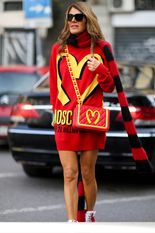A fashion WTF moment: trainers and flats at the couture shows
Was there ever an audience more out of step with the catwalk than those attending the couture shows in Paris this week?
Tottering in stilettos, they have taken their seats and waited, only to be faced with flats upon flats upon flats. And not just any flats, trainers. The most humbly practical type of flat there is.
Call it contrarian, call it rapper-fication. Whatever, the couture trainer is now 'a thing'.
At the Chanel show this morning, Karl Lagerfeld showed every look, from techy versions of the classic Chanel skirt suit to iridescent gowns, with trainers (see main image, above). Yesterday, Raf Simons at Dior suggested bejewelled sporty pumps be worn with delicate organza dresses. There were sneaks at Schiaparelli, and Carine Roitfeld has been spotted in flats, so the sea-change has apparently already taken place.
There has been a proliferation of sportswear in even the most haute ateliers in the past few seasons. The thousand-pound sweatshirts by Christopher Kane for spring; the Vans-style slip-ons from Céline, rendered in calf hair and priced around £800; the Vuitton skater jeans, the beanies, the slogan tees. It all points to designers wooing a generation sloppier than their antecedents, more interested in their own comfort than in codes of dress.
We've been calling it a 'high/low mix', except that doesn't work for luxury brands determined to win your loyalty exclusively. So, as with the rise of the couture trainer, it's 'high-high mix' all the way from now on.
It's redolent of that rich girl nonchalance in the 1990s, the hem of her full-length Tocca gown dragging in the Ibizan beer-mud because she's worn it with Converse. Except this time round, your Converse have to be Chanel.
It's the ultimate designer landgrab made by an institution that has battled accusations of irrelevance over the years, and recently emerged more influential than ever. It used to be that the flights of fantasy on the couture runway were translated into real life pieces in ready-to-wear and then watered down further for the high street. Now, the couture catwalks represent a hyper-real life, a practical vision so exquisitely crafted we all want a part of it.
Some are calling this new practicality a feminist statement, but it's more a survival tactic. Ultimately, it has been driven by Belgian pragmatist and Dior designer Raf Simons, whose conscious turning away from the opulence and theatricality of the Galliano era has made couture a commercial prospect once more. And handily, there happens to be a bigger and younger than ever wealth market for that.
So while realistic pieces on the couture catwalks might seem to speak of a certain liberation from constricting formal dress – No more ballgowns! When do we want it? Now! –what they actually signify is the industry learning a lesson from history.
Couture was crippled with the rise of mass-produced clothing in the 1960s, pieces that took couture styles as their inspiration and remade them in cheaper models. Some American sportswear designers, such as Claire McCardell, even bought Schiaparelli and Chanel pieces in order to deconstruct them and find out their underpinnings.
What couture has done this time is fight back, using the strategy that ended its 'golden age' last century. Designers are studying the streets and then realising their best possible visions of that style, turning need into want and accessibility into exclusivity.
It presages a second golden age of the discipline perhaps - one that isn't to do with feminism or what we require, but with pure fashion and what we desire.
















